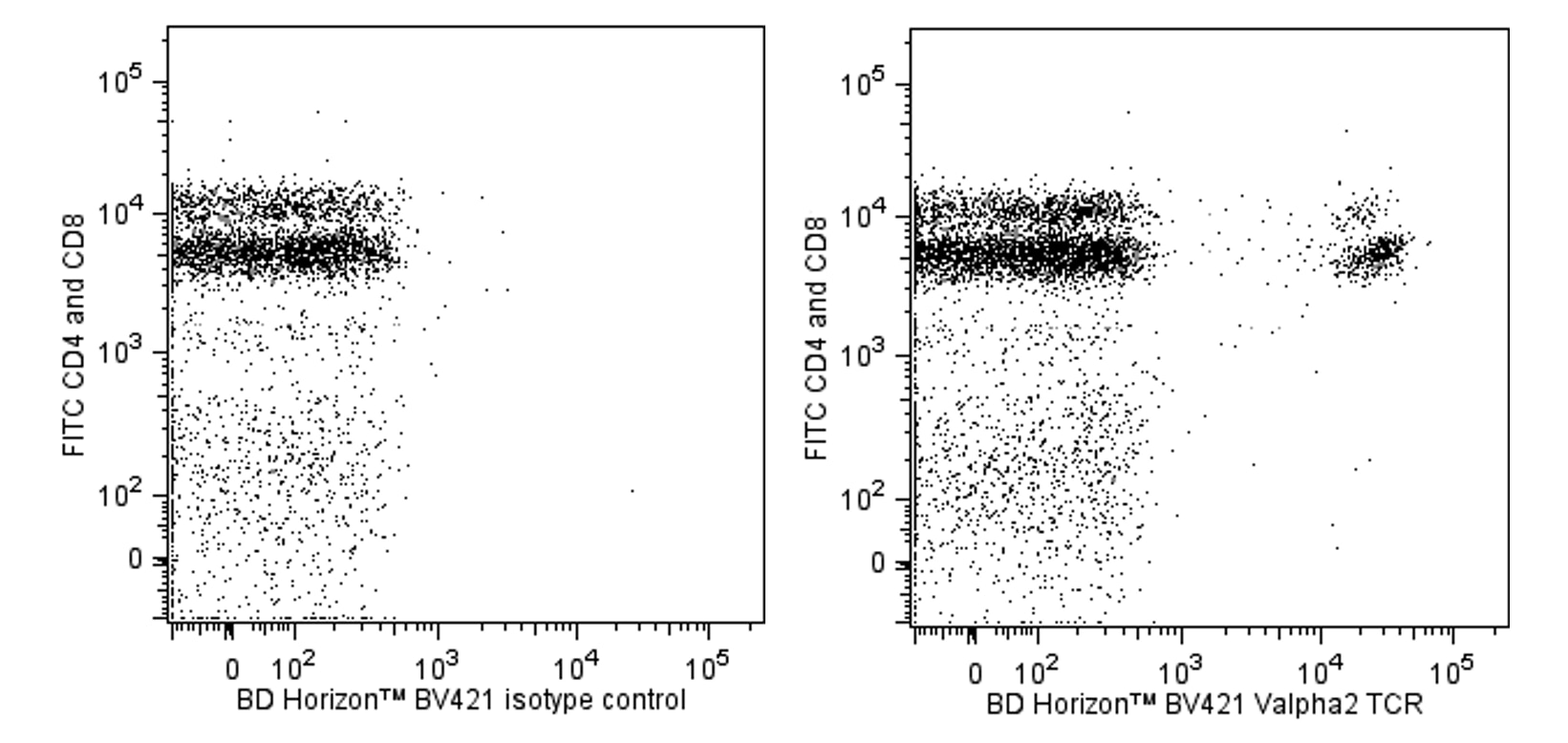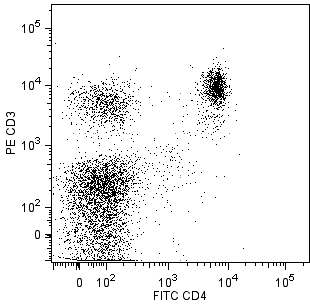-
Your selected country is
Middle East / Africa
- Change country/language
Old Browser
This page has been recently translated and is available in French now.
Looks like you're visiting us from {countryName}.
Would you like to stay on the current country site or be switched to your country?




Flow cytometric analysis of Vα2 TCR expression on mouse lymph node cells. Lymph node cells from a BALB/c mouse were stained with FITC Rat anti-Mouse CD4 (Cat. No. 553729/557307/561828) and FITC Rat anti-Mouse CD8b (Cat. No. 553040/561968) in addition to either a BD Horizon™ BV421 Rat IgG2a, λ isotype control (Cat. No. 562965, Left Panel) or with the BD Horizon™ BV421 Rat anti-Mouse Vα2 TCR antibody (Cat. No. 562944, Right Panel). Two-color flow cytometric dot plots show the correlated expression of Vα2 TCR (or Ig Isotype control staining) versus CD4 and CD8b were derived from gated events with the forward and side light-scattering characteristics of viable lymph node cells. Flow cytometry was performed using a BD™ LSR II Flow Cytometry System.


BD Horizon™ BV421 Rat Anti-Mouse Vα2 TCR

Regulatory Status Legend
Any use of products other than the permitted use without the express written authorization of Becton, Dickinson and Company is strictly prohibited.
Preparation And Storage
Product Notices
- Since applications vary, each investigator should titrate the reagent to obtain optimal results.
- Source of all serum proteins is from USDA inspected abattoirs located in the United States.
- An isotype control should be used at the same concentration as the antibody of interest.
- Please refer to www.bdbiosciences.com/us/s/resources for technical protocols.
- Caution: Sodium azide yields highly toxic hydrazoic acid under acidic conditions. Dilute azide compounds in running water before discarding to avoid accumulation of potentially explosive deposits in plumbing.
- For fluorochrome spectra and suitable instrument settings, please refer to our Multicolor Flow Cytometry web page at www.bdbiosciences.com/colors.
- Pacific Blue™ is a trademark of Molecular Probes, Inc., Eugene, OR.
- Brilliant Violet™ 421 is a trademark of Sirigen.
Companion Products


.png?imwidth=320)



The B20.1 monoclonal antibody specifically binds to most members of the Vα2 T-cell Receptor (TCR) subfamily in mice having the a, b, and c haplotypes of the Tcrb gene complex. B20.1 antibody may crossreact with Vδ8 TCR, which shares >90% sequence homology with Vα2 TCR. Levels of B20.1+ T cells appear to be influenced by Vα haplotypes. Moreover, the frequencies of Vα2+ CD8+ and CD4+ T cells are influenced by H-2 haplotypes.
The antibody was conjugated to BD Horizon™ BV421 which is part of the BD Horizon™ Brilliant Violet™ family of dyes. With an Ex Max of 407-nm and Em Max at 421-nm, BD Horizon™ BV421 can be excited by the violet laser and detected in the standard Pacific Blue™ filter set (eg, 450/50-nm filter). BD Horizon™ BV421 conjugates are very bright, often exhibiting a 10 fold improvement in brightness compared to Pacific Blue™ conjugates.

Development References (3)
-
Grégoire C, Rebaï N, Schweisguth F, et al. Engineered secreted T-cell receptor alpha beta heterodimers.. Proc Natl Acad Sci USA. 1991; 88(18):8077-81. (Immunogen: Flow cytometry, Immunoprecipitation, Radioimmunoassay). View Reference
-
Pircher H, Rebaï N, Groettrup M, et al. Preferential positive selection of V alpha 2+ CD8+ T cells in mouse strains expressing both H-2k and T cell receptor V alpha a haplotypes: determination with a V alpha 2-specific monoclonal antibody.. Eur J Immunol. 1992; 22(2):399-404. (Immunogen: Immunofluorescence). View Reference
-
Tomonari K, Fairchild S, Rosenwasser OA. Influence of viral superantigens on V beta- and V alpha-specific positive and negative selection. Immunol Rev. 1993; 131:131-168. (Methodology). View Reference
Please refer to Support Documents for Quality Certificates
Global - Refer to manufacturer's instructions for use and related User Manuals and Technical data sheets before using this products as described
Comparisons, where applicable, are made against older BD Technology, manual methods or are general performance claims. Comparisons are not made against non-BD technologies, unless otherwise noted.
For Research Use Only. Not for use in diagnostic or therapeutic procedures.
Report a Site Issue
This form is intended to help us improve our website experience. For other support, please visit our Contact Us page.